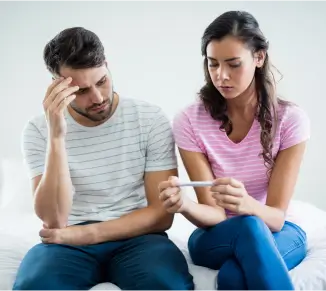Explore Your Interest
Technically, you are still not pregnant in the second week of your 40-week pregnancy, just like your week one. However, your pregnancy has begun already, and you are closer to meeting your little one even though the egg and sperm haven’t met (fertilisation).
During this week, there is no foetal movement, but your body is already preparing for the event that leads to pregnancy, which is ovulation and fertilisation. This is the time to pay attention to your body’s fertility signals and spend quality time with your partner for intimacy.
You shouldn’t stress yourself out if you do not get pregnant this time. The chance of getting pregnant with each cycle for healthy couples in their 20s and 30s is about 25 to 30 per cent on average.
Typically, your healthcare provider will calculate your due date and your pregnancy countdown from the first day of your last period, which is the standard timing for all pregnancies. Therefore, if you had just had a pregnancy test and assumed you had been pregnant for two weeks, then your pregnancy would be around week 4.
Baby Development at Week 2
There is no baby or embryo during this time, only an egg maturing and your body preparing to accommodate a visitor (sperm). The lining of the uterus is getting thicker and growing. Ovulation will occur at the end of this week, and your ovary will start to release the egg into your fallopian tubes.
The sperm from your partner can hang around your body for several days before the arrival of your egg for fertilisation; likewise, your egg can survive for 12 to 24 hours after ovulation to match up with late sperm. This is the time to be a good host for fertilisation.
It can be challenging to predict the exact day of your ovulation, and unfortunately, there is no way to tell if the egg and sperm have successfully matched until the following month.
Body Changes at Week 2
During this stage of your menstrual cycle, your period has likely ended, and one of your ovaries is gearing up to release an egg. This process is accompanied by a surge in oestrogen production, which triggers several important changes in your body. Firstly, your fallopian tubes and cervix start producing fertile mucus, which aids and protects sperm as it travels towards the egg.
A new lining called the endometrium begins to form in your uterus, providing a nourishing environment for a fertilised egg to implant and develop into a pregnancy. Towards the end of this week, ovulation occurs, marking the release of the egg from the ovary. This fertile window, characterised by the presence of cervical mucus and the possibility of ovulation, is often considered the most optimal time for conception.
Pregnancy Symptoms at Week 2
At two weeks pregnant, ovulation symptoms can indicate the optimal time for intercourse to increase the chances of conceiving a baby. According to Healthline, signs of ovulation around this time may include
Pregnancy Symptoms at Week 2
Your cervix becomes tender and open as your ovulation approaches. The cervical mucus that was initially thick, sticky or creamy begins to thin out, turning clear and watery or stretchy like a raw egg white. This new mucus gives way to sperm swimming and surviving to the egg that will soon be released.
During your most fertile period, cervical mucus can help keep sperm alive for an average of 3 days, and in some cases, even up to 5 days. This extended survival time of sperm increases the likelihood of conception occurring if intercourse takes place during this window.
Some individuals may experience mild pelvic discomfort or cramps before or during ovulation, a phenomenon known as mittelschmerz. This discomfort is often attributed to the rupture of the follicle and the release of small amounts of blood or fluid. Described as a cramp or pop, these sensations can occur in either ovary and vary in location and intensity each month. While some may feel pain on alternating sides, it’s untrue that ovaries take turns releasing eggs. The discomfort may be brief, but some individuals may experience mild pain for longer.
Changes in basal body temperature (BBT) can provide insights into ovulation patterns. BBT refers to your temperature upon waking, before any movement. After ovulation, BBT typically rises by about 1°F or less due to increased progesterone secretion and remains elevated until the start of your period if pregnancy doesn’t occur. While tracking BBT may offer clues about ovulation, it’s not infallible. Research involving over 200 women has shown that late ovulation cannot be accurately predicted by any method, including tracking basal body temperature (BBT). This study found that no signs of ovulation, including changes in BBT, perfectly align with the release of an egg.
Changes in basal body temperature (BBT) can provide insights into ovulation patterns. BBT refers to your temperature upon waking, before any movement. After ovulation, BBT typically rises by about 1°F or less due to increased progesterone secretion and remains elevated until the start of your period if pregnancy doesn’t occur. While tracking BBT may offer clues about ovulation, it’s not infallible. Research involving over 200 women has shown that late ovulation cannot be accurately predicted by any method, including tracking basal body temperature (BBT). This study found that no signs of ovulation, including changes in BBT, perfectly align with the release of an egg.
Oestrogen and progesterone can influence the texture of dried saliva, creating patterns resembling crystals or ferns, particularly before or during ovulation. However, activities like smoking, eating, drinking, and brushing teeth can obscure these patterns, diminishing their reliability as indicators of ovulation.
Your hormone changes as you approach ovulation. This change can raise sexual desire during the most fertile time in your cycle. Research shows if a woman feels more attractive than usual, she’s probably approaching ovulation.
Pregnancy Symptoms at Week 2
Your cervix becomes tender and open as your ovulation approaches. The cervical mucus that was initially thick, sticky or creamy begins to thin out, turning clear and watery or stretchy like a raw egg white. This new mucus gives way to sperm swimming and surviving to the egg that will soon be released.
During your most fertile period, cervical mucus can help keep sperm alive for an average of 3 days, and in some cases, even up to 5 days. This extended survival time of sperm increases the likelihood of conception occurring if intercourse takes place during this window.
Some individuals may experience mild pelvic discomfort or cramps before or during ovulation, a phenomenon known as mittelschmerz. This discomfort is often attributed to the rupture of the follicle and the release of small amounts of blood or fluid. Described as a cramp or pop, these sensations can occur in either ovary and vary in location and intensity each month. While some may feel pain on alternating sides, it’s untrue that ovaries take turns releasing eggs. The discomfort may be brief, but some individuals may experience mild pain for longer.
Changes in basal body temperature (BBT) can provide insights into ovulation patterns. BBT refers to your temperature upon waking, before any movement. After ovulation, BBT typically rises by about 1°F or less due to increased progesterone secretion and remains elevated until the start of your period if pregnancy doesn’t occur. While tracking BBT may offer clues about ovulation, it’s not infallible. Research involving over 200 women has shown that late ovulation cannot be accurately predicted by any method, including tracking basal body temperature (BBT). This study found that no signs of ovulation, including changes in BBT, perfectly align with the release of an egg.
Oestrogen and progesterone can influence the texture of dried saliva, creating patterns resembling crystals or ferns, particularly before or during ovulation. However, activities like smoking, eating, drinking, and brushing teeth can obscure these patterns, diminishing their reliability as indicators of ovulation.
Your hormone changes as you approach ovulation. This change can raise sexual desire during the most fertile time in your cycle. Research shows if a woman feels more attractive than usual, she’s probably approaching ovulation.
Health tips for week 2
- Get enough sleep and engage in regular exercise to help you feel good and fight off stress. This will help you maintain a healthy weight during your pregnancy.
- Taking folic acid and other prenatal vitamins before and during pregnancy is essential to obtain all the nutrients you and your developing baby need to stay healthy.
- Your body is gearing up for a significant new task, so taking good care of it is crucial. Hydrate adequately, maintain a balanced diet and eliminate unhealthy habits such as smoking or excessive coffee consumption.
- Consider stopping alcohol consumption now as a precaution, and incorporate regular moderate exercise into your routine for overall well-being.
- Moderate stress might not impact getting or staying pregnant but can affect fertility and lower sex drive, potentially leading to health issues during pregnancy; relaxation techniques and spending time with loved ones can help manage stress.
Advice for partners
- Partner support is essential when trying to conceive. During this time, partners should endeavour to participate in every aspect and not make her feel like she’s in it alone. They should also try to connect and make time for each other.
- Encourage her to take breaks and get more sleep as her body prepares for the big thing.
- Partners should avoid prolonged excessive heat like those generated from electric blankets, car seats, hot tubs, and laptops. Research has shown this kind of heat can be detrimental to temperamental testes by slowing down sperm production.
- Snuggling with your partner to stay warm will most likely produce the heat that makes a baby.
Pregnancy Checklist at Week 2
- Continue taking a daily prenatal vitamin containing folic acid.
- Keep an eye out for signs indicating ovulation
- Consider using an ovulation test kit
- Engage in intercourse every other day as you approach your fertile window.
Key Facts
- At week 2, there’s no baby or embryo, only an egg maturing while the body prepares for potential fertilisation.
- A new lining called the endometrium forms in the uterus, creating a supportive environment for the potential implantation of a fertilised egg.
- As ovulation approaches, the cervical mucus transitions from thick, sticky, or creamy to thin, clear, watery, or stretchy to facilitate sperm movement towards the egg.
- Ensure adequate sleep and regular exercise to manage stress and maintain a healthy weight during pregnancy.
- Snuggling with your partner to stay warm is conducive to conception, generating the right heat for fertility.
- To identify fertile days, monitor signs that might indicate ovulation.
Frequently Asked Questions
At week 2 of pregnancy, you would technically be in the first trimester. However, it’s essential to note that pregnancy is calculated based on the first day of your last menstrual period (LMP), which typically occurs two weeks before conception. Since conception usually occurs around week 3 of pregnancy, you may not have even conceived yet at this stage.
At week 2 of pregnancy, you have approximately 38 weeks to go until full term. Typically, pregnancies last around 40 weeks from the first day of your last menstrual period (LMP) to the estimated due date.
You will most likely not notice any symptoms at week 2 of your pregnancy, as you are not pregnant yet. However, symptoms experienced this week might be associated with ovulation.
To increase your chances of getting pregnant during your fertile window, aim to have intercourse four to five days before ovulation and during ovulation itself. Sperm can survive in the female reproductive tract for several days, so having sex before ovulation ensures that sperm are present in the fallopian tubes when the egg is released, maximising the chances of fertilisation.
Usually, at-home pregnancy tests won’t detect pregnancy until around week four or after a woman misses her first period. These tests measure specific hormones, which take time to build up to detectable levels. Typically, this doesn’t happen until around week four and is unlikely to occur during week 2. It’s advisable to wait a few days after a missed period or until a positive at-home pregnancy test before seeking confirmation from a doctor.
Frequently Asked Questions
At week 2 of pregnancy, you would technically be in the first trimester. However, it’s essential to note that pregnancy is calculated based on the first day of your last menstrual period (LMP), which typically occurs two weeks before conception. Since conception usually occurs around week 3 of pregnancy, you may not have even conceived yet at this stage.
At week 2 of pregnancy, you have approximately 38 weeks to go until full term. Typically, pregnancies last around 40 weeks from the first day of your last menstrual period (LMP) to the estimated due date.
You will most likely not notice any symptoms at week 2 of your pregnancy, as you are not pregnant yet. However, symptoms experienced this week might be associated with ovulation.
To increase your chances of getting pregnant during your fertile window, aim to have intercourse four to five days before ovulation and during ovulation itself. Sperm can survive in the female reproductive tract for several days, so having sex before ovulation ensures that sperm are present in the fallopian tubes when the egg is released, maximising the chances of fertilisation.
Usually, at-home pregnancy tests won’t detect pregnancy until around week four or after a woman misses her first period. These tests measure specific hormones, which take time to build up to detectable levels. Typically, this doesn’t happen until around week four and is unlikely to occur during week 2. It’s advisable to wait a few days after a missed period or until a positive at-home pregnancy test before seeking confirmation from a doctor.
1. American College of Obstetricians and Gynecologists. Having a Baby After Age 35: How Ageing Affects Fertility and Pregnancy.
2. American College of Obstetricians and Gynecologists. Trying to get Pregnant? Here’s When to Have sex.
3. Clubb E. Natural methods of family planning. Journal of the Royal Society of Health. 1986 Aug;106(4):121-6.
4. Eunice Kennedy Shriver National Institute Of Child Health and Human Development. Will stress during pregnancy affect my baby?.
5. Healthline. What are the Signs and Symptoms of Ovulation?
6. Male Infertility Guide. The Impact of Temperature and Excessive Heat on Sperm Quality.
7. Medical News Today. What are the signs of pregnancy in week 2?
8. Raising Children. 2 weeks pregnant.
9. Schleifenbaum, L., Driebe, J.C., Gerlach, T.M., Penke, L. and Arslan, R.C., 2021. Women feel more attractive before ovulation: Evidence from a large-scale online diary study. Evolutionary Human Sciences, 3, p.e47.
10. Wilcox, A.J., Dunson, D. and Baird, D.D., 2000. The timing of the “fertile window” in the menstrual cycle: day specific estimates from a prospective study. Bmj, 321(7271), pp.1259-1262.





